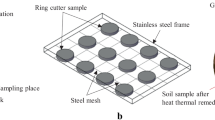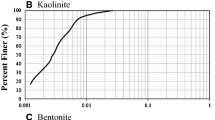Abstract
High energy consumption is a serious issue associated with in situ thermal desorption (TD) remediation of sites contaminated by petroleum hydrocarbons (PHs). The knowledge on the thermophysical properties of contaminated soil can help predict accurately the transient temperature distribution in a remediation site, for the purpose of energy conservation. However, such data are rarely reported for PH-contaminated soil. In this study, by taking diesel as a representative example for PHs, soil samples with constant dry bulk density but different diesel mass concentrations ranging from 0% to 20% were prepared, and the variations of their thermal conductivity, specific heat capacity and thermal diffusivity were measured and analyzed over a wide temperature range between 0°C and 120°C. It was found that the effect of diesel concentration on the thermal conductivity of soil is negligible when it is below 1%. When diesel concentration is below 10%, the thermal conductivity of soil increases with raising the temperature. However, when diesel concentration becomes above 10%, the change of the thermal conductivity of soil with temperature exhibits the opposite trend. This is mainly due to the competition between soil minerals and diesel, because the thermal conductivity of minerals increases with temperature, whereas the thermal conductivity of diesel decreases with temperature. The analysis results showed that, compared with temperature, the diesel concentration has more significant effects on soil thermal conductivity. Regardless of the diesel concentration, with the increase of temperature, the specific heat capacity of soil increases, while the thermal diffusivity of soil decreases. In addition, the results of a control experiment exhibited that the relative differences of the thermal conductivity of the soil samples containing the same concentration of both diesel and a pure alkane are all below 10%, indicating that the results obtained with diesel in this study can be extended to the family of PHs. A theoretical prediction model was proposed based on cubic fractal and thermal resistance analysis, which confirmed that diesel concentration does have a significant effect on soil thermal conductivity. For the sake of practical applications, a regression model with the diesel concentration as a primary parameter was also proposed.
Similar content being viewed by others
Abbreviations
- α :
-
Thermal diffusivity/m·2s−1
- c p :
-
Specific heat capacity/kJ·(kg·°C)−1
- k :
-
Thermal conductivity/W·(m·°C)−1
- L :
-
Side length/m
- m :
-
Mass/kg
- n :
-
Porosity/%
- R :
-
Thermal resistance/m2·K·W−1
- V :
-
Volume/m3
- θ :
-
Mass fraction
- ρ :
-
Density/kg·m−3
- ϕ :
-
Volume fraction
- a:
-
Air
- d:
-
Diesel
- d,a:
-
Diesel-air mixture
- dry:
-
Dry soil
- s:
-
Solid phase in soil
- I:
-
Fractal part of a soil unit
- I1:
-
Fractal part of a soil unit
- I2:
-
Fractal part of a soil unit
- I3:
-
Fractal part of a soil unit
- II:
-
Fractal part of a soil unit
- DSC:
-
Differential scanning calorimeter
- PHs:
-
petroleum hydrocarbons
- RMSV:
-
Ratio of mean square value
- SEM:
-
Scanning electron microscope
- TD:
-
Thermal desorption
References
Zivdar Z., Heidarzadeh N., Asadollahfardi G., Remediation of diesel-contaminated soil by low-temperature thermal desorption. International Journal of Environmental Science and Technology, 2019, 16: 6113–6124.
Gimžauskaitė D., Tamošiūnas A., Tučkutė S., et al., Treatment of diesel-contaminated soil using thermal water vapor arc plasma. Environmental Science and Pollution Research, 2020, 27: 43–54.
Pinedo J., Ibáñez R., Lijzen J.P.A., et al., Assessment of soil pollution based on total petroleum hydrocarbons and individual oil substances. Journal of Environmental Management, 2013, 130: 72–79.
Lominchar M.A., Santos A., de Miguel E., et al., Remediation of aged diesel contaminated soil by alkaline activated persulfate. Science of the Total Environment, 2018, 622–623: 41–48.
Wu H., Sun L.N., Wang H., et al., Persulfate oxidation for the remediation of petroleum hydrocarbon-contaminated soils. Polish Journal of Environmental Studies, 2016, 25(2): 851–857.
Rongsayamanont W., Tongcumpou C., Phasukarratchai N., Diesel-contaminated soil washing by mixed nonionic surfactant emulsion and seed germination test. Water, Air, & Soil Pollution, 2020, 231: 267.
Li D.C., Xu W.F., Mu Y, et al., Remediation of petroleum-contaminated soil and simultaneous recovery of oil by fast pyrolysis. Environmental Science & Technology, 2018, 52: 5330–5338.
Sun H., Yang X.R., **e J.Y., et al., Remediation of diesel-contaminated aquifers using thermal conductive heating coupled with thermally activated persulfate. Water, Air, & Soil Pollution, 2021, 232: 293.
van Hullebusch E.D., Huguenot D., Pechaud Y., et al., Environmental soil remediation and rehabilitation. Springer International Publishing, 2020.
Vidonish J.E., Alvarez P.J.J., Zygourakis K., Pyrolytic remediation of oil-contaminated soils: Reaction mechanisms, soil changes, and implications for treated soil fertility. Industrial & Engineering Chemistry Research, 2018, 57: 3489–3500.
Yi Y.M., Park S.Y., Munster C., et al., Contaminated soil after low-temperature thermal desorption treatment. Water, Air, & Soil Pollution, 2016, 227: 108.
O’Brien P.L., DeSutter T.M., Casey F.X.M., et al., Thermal remediation alters soil properties–A review. Journal of Environmental Management, 2018, 206: 826–835.
Sang Y.M., Yu W., He L., et al., Sustainable remediation of lube oil-contaminated soil by low temperature indirect thermal desorption: removal behaviors of contaminants, physicochemical properties change and microbial community recolonization in soils. Environmental Pollution, 2021, 287: 117599.
Bartsch Z.J., DeSutter T.M., Gasch C.K., et al., Plant growth, soil properties, and microbial community four years after thermal desorption. Agronomy Journal, 2022, 114: 1011–102.
Falciglia P.P., Giustra M.G., Vagliasindi F.G.A, Soil texture affects adsorption capacity and removal efficiency of contaminants in ex situ remediation by thermal desorption of diesel-contaminated soils. Chemistry and Ecology, 2011, 27(S1): 119–130.
Kosegi J.M., Minsker B.S., Dougherty D.E., Feasibility study of thermal in situ bioremediation. Journal of Environmental Engineering, 2000, 126(7): 601–610.
Sun Z.P., Wang L., Yang S.C., et al., Thermally enhanced anoxic biodegradation of polycyclic aromatic hydrocarbons (PAHs) in a highly contaminated aged soil. Journal of Environmental Chemical Engineering, 2022, 10: 107236.
Johansen O., Thermal conductivity of soils. Dissertation, Trondheim University, Trondheim, 1975.
Brandon T.L., Mitchell J.K., Factors influencing thermal resistivity of sands. Journal of Geotechnical Engineering, 1989, 115(12): 1683–1698.
Côté J., Konrad J.M., A generalized thermal conductivity model for soils and construction materials. Canadian Geotechnical Journal, 2005, 42(2): 443–458.
Lu S., Ren T.S., Gong YS., et al., An improved model for predicting soil thermal conductivity from water content at room temperature. Soil Science Society of America Journal, 2007, 71(1): 8–14.
Wu Y.H., Feng Y.H., Fan L.W., et al., Effects of moisture content and dry bulk density on the thermal conductivity of compacted backfill soil. Journal of Zhejiang University-Science A (Applied Physics & Engineering), 2022, 23(8): 610–620.
Mostaghimi J., Pfender E., Measurement of thermal conductivities of soils. Wärme- und Stoffübertragung, 1980, 13: 3–9.
Lu N., Dong Y., Closed-form equation for thermal conductivity of unsaturated soils at room temperature. Journal of Geotechnical and Geoenvironmental Engineering, 2015, 141(6): 04015016.
Li K.Q., Kang Q., Nie J.Y., et al., Artificial neural network for predicting the thermal conductivity of soils based on a systematic database. Geothermics, 2022, 103: 102416.
Malyshev A.V., Timofeev A.M., Considering temperature dependence of thermo-physical properties of sandy soils in two scenarios of oil pollution. Sciences in Cold and Arid Regions, 2014, 6: 302–308.
Ministry of Ecological and Environment of the People’s Republic of China, HJ 1021–2019 Soil and sediment—Determination of petroleum hydrocarbons (C6–C9)—Purge and trap/gas chromatography. National Standards of the People’s Republic of China, 2019. (in Chinese)
Ministry of Ecological and Environment of the People’s Republic of China, HJ 1021–2019 Soil and sediment—Determination of petroleum hydrocarbons (C10–C40)—Gas chromatography. National Standards of the People’s Republic of China, 2019. (in Chinese)
Ministry of Housing and Urban-Rural Development of the People’s Republic of China, GB/T 50123-2019 Standard for geotechnical testing method. National Standards of the People’s Republic of China, 2019. (in Chinese)
Xu L., Yuan H.M., Jiang R.F., et al., Advances in X-ray diffraction for the determination of clay minerals in soil. Spectroscopy and Spectral Analysis, 2020, 40(4): 1227–1231. (in Chinese)
Wu Y.H., Yin L.P., Wang Q., et al., Changes in thermal conductivity of organic contaminated clay loam after thermal desorption. Chinese Journal of Environmental Engineering, 2021, 15(12): 3967–3973. (in Chinese)
Mackay D., Shiu W.Y., Ma K.C., et al., Handbook of physical-chemical properties and environmental fate for organic chemicals (2nd edtion). CRC Press, 2006.
Chiu L.F., Liu H.F., Li M.H., Heat capacity of alkanolamines by differential scanning calorimetry. Journal of Chemical & Engineering Data, 1999, 44(3): 631–636.
Xu X.T., Zhang W.D., Fan C.X., et al., Effects of temperature, dry density and water content on the thermal conductivity of Genhe silty clay. Results in Physics, 2020, 16: 102830.
Modi S.K., Durga P.B., Basavaraj M., Effect of moisture content and temperature on thermal conductivity of Psidium guajava L. by line heat source method (transient analysis). International Journal of Heat and Mass Transfer, 2014, 78: 354–359.
United States Department of Agriculture Natural Resources Conservation Service, A tool to determine soil texture based on percent sand, silt, and clay. An official website of the United States government, 2017, https://view.officeapps.live.com/op/view.aspx?src=https%3A%2F%2Fwww.nrcs.usda.gov%2Fsites%2Fdefault%2Ffiles%2F2022-11%2FMultiPointTriangle_v1.xlsm&wdOrigin=BROWSELINK (accessed on May 30, 2022).
Zheng X., Qu D., Zhang F., et al., Measurements and calculations of thermal conductivity for liquid n-octane and n-decane. Fluid Phase Equilibria, 2021, 533: 112940.
Wada Y., Nagasaka Y., Nagashima A., Measurements and correlation of the thermal conductivity of liquid n-paraffin hydrocarbons and their binary and ternary mixtures. International Journal of Thermophysics, 1985, 6(3): 251–265.
Gemant A., The thermal conductivity of soils. Journal of Applied Physics, 1950, 21(8): 750–752.
Chen Y.P., Shi M.H., Determination of effective thermal conductivity for real porous media using fractal theory. Journal of Thermal Science, 1999, 8(2): 102–107.
Lehmann P., Stähli M., Papritz A., et al., A fractal approach to model soil structure and to calculate thermal conductivity of soils. Transport in Porous Media, 2003, 52: 313–332.
Acknowledgments
This study was financially supported by the National Key Research and Development Program (project No. 2019YFC1805700; program No. 2019YFC1805701).
Author information
Authors and Affiliations
Corresponding author
Ethics declarations
FAN Liwu is an editorial board member for Journal of Thermal Science and was not involved in the editorial review or the decision to publish this article. All authors declare that there are no competing interests.
Rights and permissions
About this article
Cite this article
Wu, Y., Wu, Y., Luo, G. et al. Effects of Diesel Concentration on the Thermal Conductivity, Specific Heat Capacity and Thermal Diffusivity of Diesel-Contaminated Soil. J. Therm. Sci. 33, 696–709 (2024). https://doi.org/10.1007/s11630-024-1948-6
Received:
Published:
Issue Date:
DOI: https://doi.org/10.1007/s11630-024-1948-6




